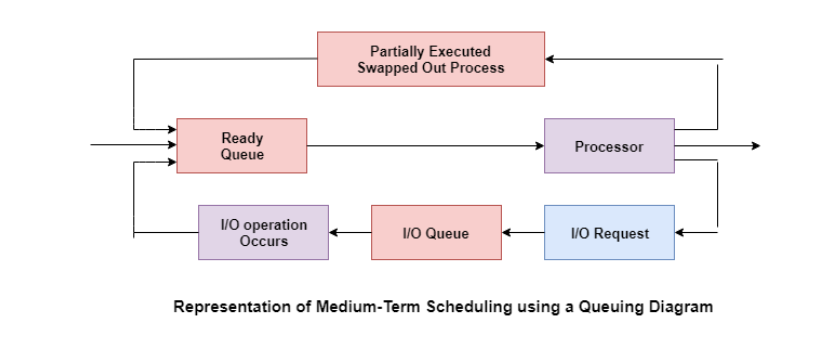
 Data Structure
Data Structure Networking
Networking RDBMS
RDBMS Operating System
Operating System Java
Java MS Excel
MS Excel iOS
iOS HTML
HTML CSS
CSS Android
Android Python
Python C Programming
C Programming C++
C++ C#
C# MongoDB
MongoDB MySQL
MySQL Javascript
Javascript PHP
PHP
- Selected Reading
- UPSC IAS Exams Notes
- Developer's Best Practices
- Questions and Answers
- Effective Resume Writing
- HR Interview Questions
- Computer Glossary
- Who is Who
Different Types of Process Schedulers
Process Scheduling handles the selection of a process for the processor on the basis of a scheduling algorithm and also the removal of a process from the processor. It is an important part of multiprogramming operating system.
There are many scheduling queues that are used in process scheduling. When the processes enter the system, they are put into the job queue. The processes that are ready to execute in the main memory are kept in the ready queue. The processes that are waiting for the I/O device are kept in the I/O device queue.
The different schedulers that are used for process scheduling are −
Long Term Scheduler
The job scheduler or long-term scheduler selects processes from the storage pool in the secondary memory and loads them into the ready queue in the main memory for execution.
The long-term scheduler controls the degree of multiprogramming. It must select a careful mixture of I/O bound and CPU bound processes to yield optimum system throughput. If it selects too many CPU bound processes then the I/O devices are idle and if it selects too many I/O bound processes then the processor has nothing to do.
The job of the long-term scheduler is very important and directly affects the system for a long time.
Short Term Scheduler
The short-term scheduler selects one of the processes from the ready queue and schedules them for execution. A scheduling algorithm is used to decide which process will be scheduled for execution next.
The short-term scheduler executes much more frequently than the long-term scheduler as a process may execute only for a few milliseconds.
The choices of the short term scheduler are very important. If it selects a process with a long burst time, then all the processes after that will have to wait for a long time in the ready queue. This is known as starvation and it may happen if a wrong decision is made by the short-term scheduler.
A diagram that demonstrates long-term and short-term schedulers is given as follows −
Medium Term Scheduler
The medium-term scheduler swaps out a process from main memory. It can again swap in the process later from the point it stopped executing. This can also be called as suspending and resuming the process.
This is helpful in reducing the degree of multiprogramming. Swapping is also useful to improve the mix of I/O bound and CPU bound processes in the memory.
A diagram that demonstrates medium-term scheduling is given as follows −


